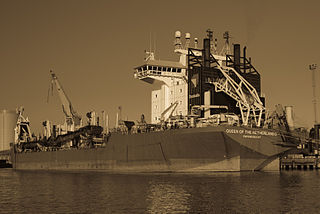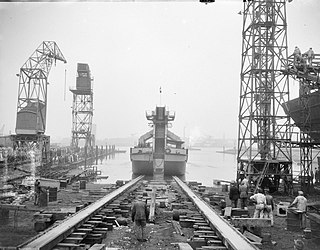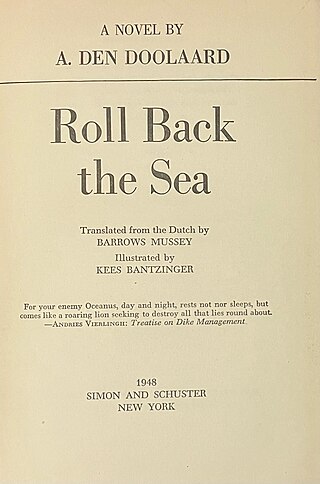
Dredging is the excavation of material from a water environment. Possible reasons for dredging include improving existing water features; reshaping land and water features to alter drainage, navigability, and commercial use; constructing dams, dikes, and other controls for streams and shorelines; and recovering valuable mineral deposits or marine life having commercial value. In all but a few situations the excavation is undertaken by a specialist floating plant, known as a dredger.

USS Millard County (LST-987) was an LST-542-class tank landing ship built for the United States Navy during World War II. Named after Millard County, Utah, it was the only U.S. Naval vessel to bear the name.

The Underfall Yard is a historic boatyard on Spike Island serving Bristol Harbour in England.

Mercator Limited is an Indian company. It was earlier known as Mercator Lines Ltd. The Mercator group of companies has diversified business interests in Coal, Oil & Gas, Commodity Transportation, and Dredging. Mercator Limited is the parent company and was the second largest private sector shipping company in India, and it is based in Mumbai. It was amongst the highest wealth creators in the Indian stock exchanges between 2000 -2010.

Boskalis Westminster N.V. is a Dutch dredging and heavylift company that provides services relating to the construction and maintenance of maritime infrastructure internationally. The company has one of the world's largest dredging fleets, a large stake in Smit International and owns Dockwise, a large heavylift shipping company.

Queen of the Netherlands is a Dutch trailing suction hopper dredger ship constructed in 1998. After lengthening in 2009, she was the largest and most powerful dredger in the world. The vessel has been used in high-profile salvage and dredging operations including the investigation into the Swissair Flight 111 crash and in the Port Phillip Channel Deepening Project. It has been called "the world's largest floating vacuum cleaner".

Jan De Nul Group is a Belgian family-owned company, with the financial headquarters in Luxembourg, that provides services relating to the construction and maintenance of maritime infrastructure on an international basis. Its main focus is dredging, which accounts for 85% of its turnover. Other areas include civil engineering and environmental technology.

The TSHD Shoalway is a trailing suction hopper dredger, owned and operated by Royal Boskalis Westminster, originally intended for the British market and built in 2010.
Dredging, Environmental and Marine Engineering NV (DEME) is an international group of specialised companies in the fields of capital and maintenance dredging, land reclamation, port infrastructure development, offshore related services for the oil & gas industry, offshore windfarm installation, and environmental remediation. The group is based in Zwijndrecht, Belgium, and has current operations on five continents.

The Mafuta is a diamond-mining ship owned and operated by De Beers in the western coast of South Africa. Built in 1983 as Dock Express 20 for Dock Express Shipping, the semisubmersible, multirole, heavy-lift vessel was converted to the world's largest cable layer in 1993. In 2005, she was purchased by De Beers, and converted to a subsea diamond-mining ship by A&P Tyne over the course of 11 months. The ship's new name, Peace in Africa, may have implied that it was providing an alternative to blood diamonds. In 2013, still under ownership of De Beers Marine Namibia, the vessel was renamed to MV Mafuta.

A Slice of Reality is a work of modern art by Richard Wilson sitting by the Millennium Dome on the north-western bank of the Greenwich Peninsula. It consists of a 9-metre (30 ft) sliced vertical section through the former 800-ton 60-metre (200 ft) sand dredger Arco Trent and exposes portions of the former living quarters of the vessel to the elements.

A trailing suction hopper dredger (TSHD) is a type of ship capable of maintaining navigable waterways, deepening the maritime canals that are threatened to become silted, constructing new land elsewhere or replacing sand eroded by storms or wave action on the beaches. This is made possible by large, powerful pumps and engines able to suck sand, clay, silt and gravel.
Trailing Suction Hopper Dredger Congo River is the newest ship of the DEME fleet with the biggest hopper capacity: 30,190 m3. DEME N.V. signed a contract with IHC Dredgers B.V. for the design, construction, and delivery of the ship.

The TSHD WD Mersey is a British trailing suction hopper dredger, owned and operated by Boskalis Westminster Ltd and built in Italy. The ship maintained ports around the British Isles, including Liverpool, the Manchester Ship Canal, Harwich, Heysham and the Firth of Clyde

Dredging Corporation of India Limited, or DCI, is an Indian dredging company which does dredging for Indian seaports exclusively. It occasionally dredges at foreign seaports in countries such as Sri Lanka, Taiwan and Dubai. It is mainly involved in maintenance dredging. Almost all the maintenance dredging in Indian seaports is carried out by DCI due to government regulations. DCI is also involved in capital dredging, beach nourishment, and land reclamation. The main seaports in which DCI does business are Visakhapatnam Port, Haldia, Kandla, Cochin Port and Ennore Port.

Spartacus is a cutter suction dredger (CSD) that entered service in August 2021 for DEME. She is the largest and most powerful ship of her type in the world.

J. & K. Smit was a Dutch shipbuilding company located in Kinderdijk and Krimpen aan de Lek. Its successor is now part of Royal IHC.

Royal IHC or Koninklijke IHC, previously IHC Holland (1943–1995), IHC Holland Merwede (1995–2005) and IHC Merwede (2005–2014) is a Dutch shipbuilding company with headquarters in Kinderdijk. It focuses on the development, design and construction of ships for the dredging and offshore industries.

The Corozal was a Scottish-built dredger used on the Panama Canal. The Renfrew-based firm of Messrs. Wm. Simons & Company won a US government tender for its construction in 1911. The vessel was launched in November 1911 and taken into US government service as the US Corozal. It was the most powerful dredger ever built at that time. The Corozal operated on the difficult Culebra Cut, deepening a channel excavated by hand and dynamite. It became the first ship to sail through the cut in December 1913, shortly before the canal opened to traffic. The Corozal was sold to the Arundel Corporation in 1926 and scrapped in 1956.

Het verjaagde water is a 1947 Dutch non-fiction novel written by A. den Doolaard, which gives an account of the recovery works to repair dike breaches after the October 1944 Inundation of Walcheren as part of operations by The Allies of World War II during Operation Infatuate. Researchers from Delft University of Technology have found high levels of historical accuracy in den Doolaard's descriptions of the events that took place, the methods used to close the dikes and the key people involved. Den Doolaard assigned pseudonyms to most of the main characters and organisations. The name A. den Doolaard is also a pseudonym, the author’s real name being Cornelis Johannes George Spoelstra Jr.

















